Kadavur - A Place where Slender Loris roam in Peace
Aptly described as slender loris, a species of primate commonly found in the tropical scrub and deciduous forests as well as the dense scrub forests of Southern India and Sri Lanka. The small, nocturnal, and arboreal. has been in the news because of its depleting population. Realizing the need for immediate conservation of this species endemic to south India. Recently the state of Tamil Nadu has done a laudable job to conserve endangered species first in the country. The small hamlet Kadavur is home to forest child. The path-breaking initiative has put sleepy hamlet on the world map!

Maybe because of only very few interactions with this lonely arboreal cute little creature in the wild.Though I was fascinated by its dish eyes and slow gestures. I knew only little and rather did I make any attempts to know about it seriously. My interest did develop, until I came to know about a Wildlife Sanctuary been declared the first of its kind in the country for this Slender looking Primate often referred to as kaadu paapa – the baby of the forest popularly known as Slender or Slow Loris.
However, avid interest gave me wings to know, about it...more and more...
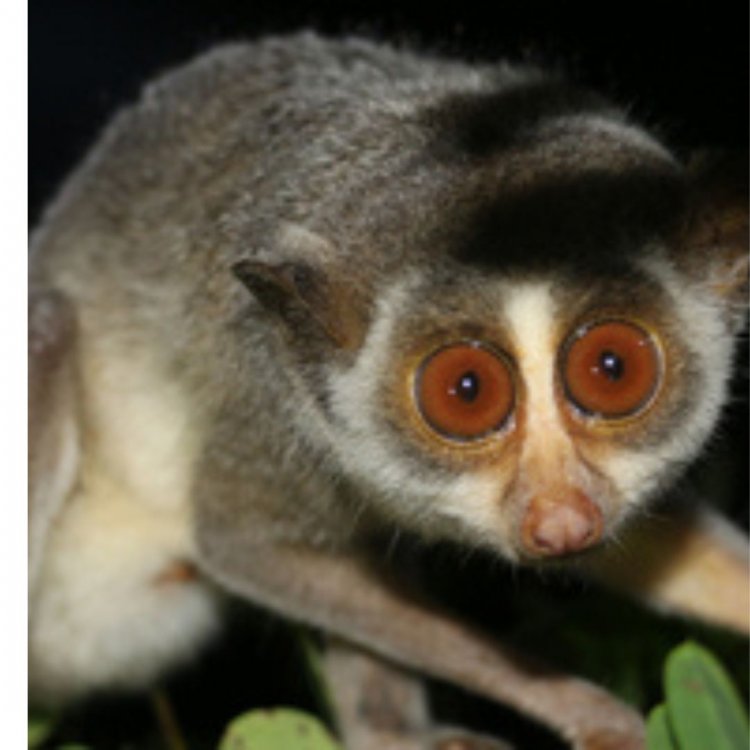
Slow lorises are a unique group of primates found throughout South and Southeast Asia. Pair of circular powerful dish eyes, their vice-like grip, snake-like movements, shy nature, and most remarkably, their venomous bite, make them unique among primates. They also are to many people undeniably adorable, and to others, nature's answer to over 100 diseases their slow movements make them easy prey.
What was the reason to take such a humongous decision, that made to declare a Vast area as a reserved forest in Tamil Nadu.?
However, to gain formal permission to sight them and explore the newly declared Sanctuary located next door in the state of Tamil Nadu was a herculean task, because of entry formalities. During a casual encounter, I was fortunate to tag with DFO on deputation. After noticing my keen interest and previous explorations, he granted us permission for a very short visit.
The scorching heat of summer on one side, we had just landed from our Flamingo photography trip from Pulicat. The sudden weather changes were playing a spoilsport. However, we made a decision for a quick visit to Kadavur
The weather pattern changed, as per weather predictions. Heavy downpours in the steel city, Salem. Drastic change and humid weather prevailed as we neared Karur and Dindigul was a respite. As rains may hamper our plans. We reached Ayyalur late at night after a 7-hour-long journey.
A Sanctuary for Slender Loris. Why
It was a common question that lingered in my mind until I spoke to Mr. Kumarashen. The charge RFO was eager to answer all our doubts. the late night patiently after receiving us at his office.
A slim, nocturnal, and very slow-moving animal by nature, slender loris is generally found in the dry areas of the Dindigul district of Tamil Nadu,
They are territorial, and terrestrial usually found and stay amid acacia trees - Carnatic Umbrella thorn rain forest, palms, euphorbias, and cacti are the main plants found in these forests. They feed on insects, lizards, small birds, and wild berries.
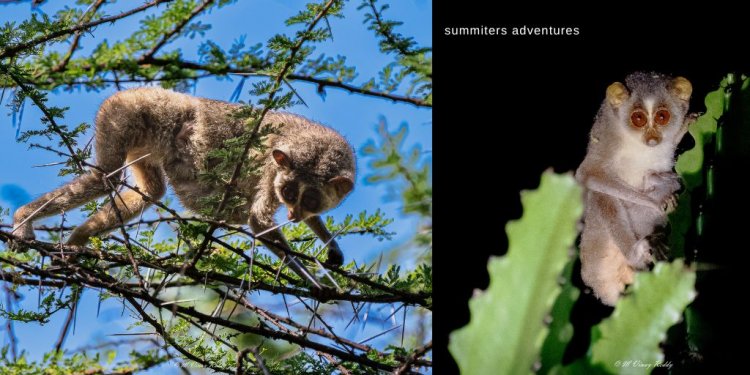
This small animal has been in the news ever since the Tamil Nadu government announced the very first sanctuary for this primate in the state, spread across 11,806 hectares in Karur and Dindigul districts.
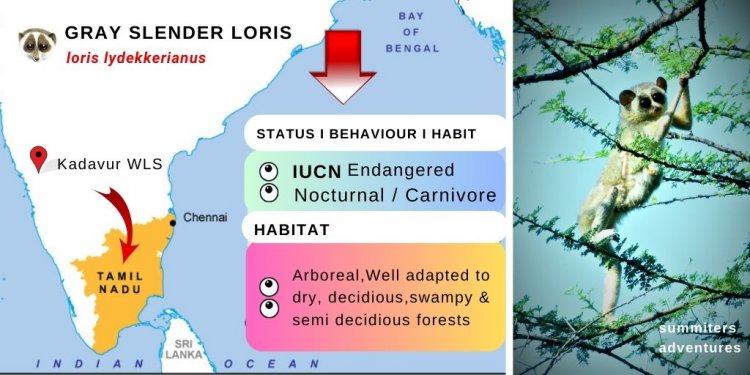
A joint discussion with RFO Ayyalur range, forest watchers, ground staff, local guides, and village folk revealed that the reason for the depletion of species and becoming endangered was because of varied reasons.


In December 2021, responding to a PIL, the Madurai Bench of the Madras High Court directed the forest authorities to conduct a census of slender loris in Tamil Nadu. The slender loris is considered endangered according to IUCN and is listed on the Red List of Threatened Species under Appendix II of the Convention on International Trade in Endangered Species of Wild Fauna and Flora.
According to Mr Kumareshan, In the year 2022 Scientists from the Salim Ali Centre for Ornithology and Natural History (SACON) in Coimbatore carried out a survey of slender loris populations in Tamil Nadu. The survey revealed that only 1165 survived and were only left in the wild. The joint observation and reports said that Ayyalur, Sirumalai, and Natham forest total 4 other ranges are ideal for the conservation of Slender Loris because of the different species of Acacia species including, Acacia planifrons that profusely grow here.
Wildlife activists had proposed the creation of a sanctuary for the protection of this primate, which is primarily an insectivorous species. The concern was declaring any area as a sanctuary is only the first step in a series of steps that actually show results on the ground. It is a long process. The first and foremost step is to create awareness among people and gets local communities interested in conservation.” Dinesh one of the forest staff added that “ Not just slender loris, other species such as mouse deer and Jackals also need to be considered for conservation efforts in the sanctuary.”
Since then, being mostly reclusive, this primate has been the prime concern of consistent conservation.

Our Night Out in Search of Baby
Accompanied by forest watchers, and a local villager Ayyappan we headed to Berangi Karadu in the Ayyalur forest range. We traveled by jeep up to the last road head and then followed him armed with headlamps and lenses. Ayyappan pointed out a flash of light between the bushes. As we neared we could see the movement and whistling sound of Slender Loris amidst the foliage. Soon we could notice a solitary mother with a young one embracing her on a cactus plant.
The thorn forest was difficult to maneuver in the dark without powerful headlamps and torches. The Loris was very protective and stood still, protecting its young one. It kept peeping through the cacti, winking its eyes once in a while. As we engaged in photographing them, we could hear a Chittering sound. As we moved forward, it kept staring at us making a squeal - To Alarm the other family members in the vicinity.

We were told that they make different and unique calls and are difficult to imitate which may during mating attract the opposite sex. We could hear a continuous, call and it was unique. It was known as the Zick call. We were told that the young ones normally contact and communicate with the mother.
I was surprised to see a swarm of butterflies fluttering in the thickets, our focused lights made them glow. A spider blocking our way, busy in the hunt looked colorful in the dark. Though a few mentioned that they could hear the call of mouse deer, we could not spot them as all were hooked to sloris.!
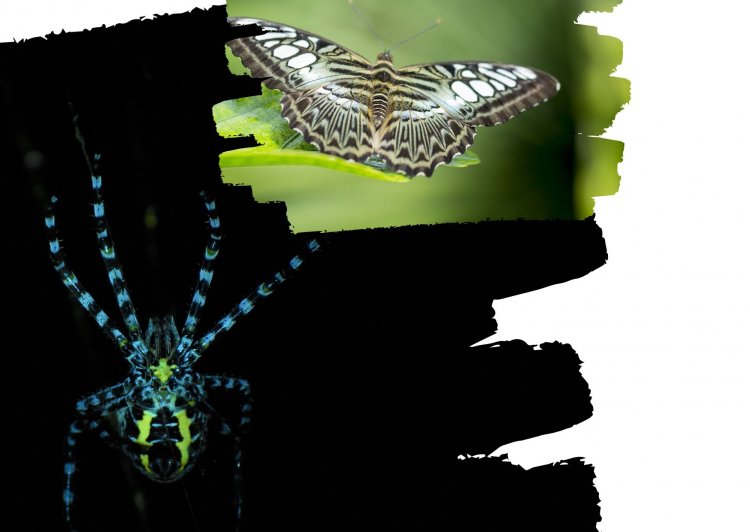
We returned at midnight around 12;30 after spending precious time with primates. We stayed in the forest rest house at Ayyalur. The next morning we woke to the song of treepies and parakeets. We had decided the previous day to spot them in the adjoining forest range. Our local guide Ayyappa was ready to greet us and after a cup of hot tea and packed breakfast, we moved to the scrub forest armed with binoculars.
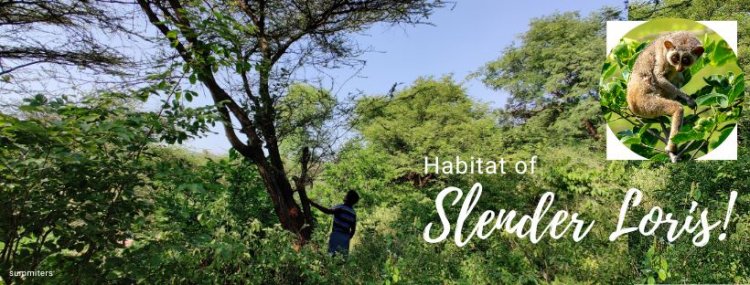
Ayyappa did not take much time to spot the cuties as it was a backyard activity for him. We roamed in the thickets and spotted a few and most of them were female with young ones.
One of the highly commendable works that local folk and forest department are engaged in is to safeguard the dwindling population of Slender Loris - thevaangu as they call it in Tamil. They have stopped picking firewood from the forest and working with the forest department to protect their child.
Mr. Kumarasen explained, how they caressed and treated the slender loris young ones who lost their mother in a road accident. Feeding them cows' milk using ink filler for more than 90 days. One needs to have the patience to handle them gently. The attachment and bondage that they have towards humans are similar to parents and children.
Photo courtesy - Forest Department, Ayyalur TN
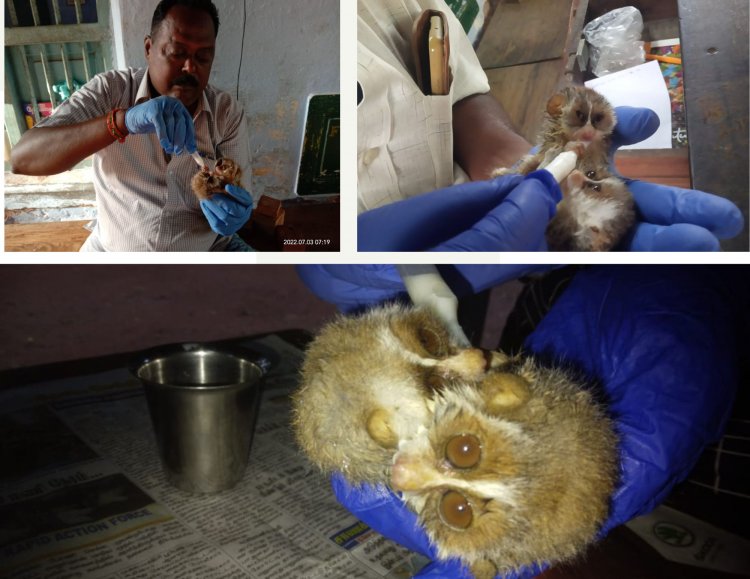
The Forest Department staff are engaged in creating awareness programs soon after declaring Kadavur as a protected area.
1. Creating Awareness generation programs on Slender loris conservation
2. Group formation and Training
3. Training poachers in alternate livelihood methods and supporting them
4. Support tribal women with skill training on value-adding nontimber forest products, which will economically develop their status
5. Training and motivating vegetable farmers in fringe villages, for reducing pesticide load in their farming
6. Preparation of saplings and Planting of a native variety of acacia trees (Naatu Karuvel) on public and private lands

The approach is to support livelihood and conservation both simultaneously, without one affecting the other.
It is our duty to protect the habitat and see to it the disappearance of Gray loris species forever. our planet. He adds“But, in reality, if a sanctuary is formed, it may give rise to a lot of practical problems. Once a sanctuary is formed, the question of declaring the Eco-Sensitive Zone (ESZ) will arise and all the 18 hamlets located on the Kadavur hills will be badly affected as they are located within the limit.
The fight for survival persists, as every living being on earth has the right to live. Either small or big. However, I remember the theory of Charles Darwin's survival theory of the strongest...
It is not the strongest of the species that survive, nor the most intelligent, but the one most responsive to change













